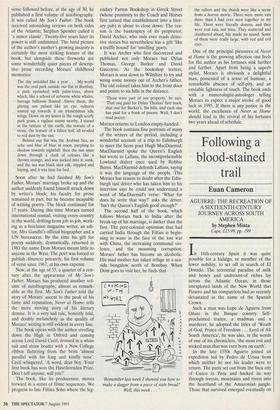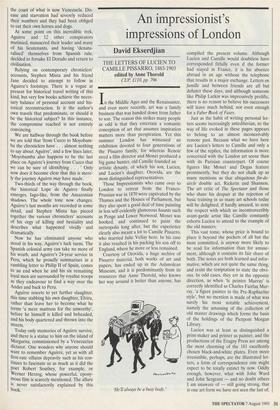Following a blood-stained trail
Euan Cameron
AGUIRRE: THE RECREATION OF A SIXTEENTH-CENTURY JOURNEY ACROSS SOUTH AMERICA by Stephen Minta Cape, £15.99, pp. 199 In 16th-century Spain it was quite possible for a hidalgo, or member of the lower nobility, to set off in search of El Dorado. The terrestrial paradise of milk and honey and undreamt-of riches lay across the Atlantic Ocean, in those unexplored lands of the New World that Pizarro and his compatriots had so recently devastated in the name of the Spanish Crown.
Such a man was Lope de Aguirre from (Mate in the Basque country. Self- proclaimed traitor, a madman and a murderer, he adopted the titles of 'Wrath of God, Prince of Freedom . . . Lord of All South America'; he was also, in the words of one of his chroniclers, 'the most evil and wicked man that was ever born on earth'.
In the late 1550s Aguirre joined an expedition led by Pedro de Ursua from which neither he nor his leader were to return. The party set out from the Inca city of Cuzco in Peru and hacked its way through forests, mountains and rivers into the heartland of the Amazonian jungle. Those that survived emerged eventually on
the coast of what is now Venezuela. Dis- ease and starvation had severely reduced their numbers and they had been obliged to eat their own horses and dogs.
At some point on this incredible trek, Aguirre and 12 other conspirators mutinied, massacred their leader and many of his lieutenants, and having 'denatu- ralised' themselves from Spanish rule, decided to forsake El Dorado and return to civilisation.
Relying on contemporary chroniclers' accounts, Stephen Minta and his friend Jane decided to attempt to follow in Aguirre's footsteps. There is a vogue at present for historical travel writing of this kind, but very few books achieve the neces- sary balance of personal account and his- torical reconstruction. Is it the author's own travels that predominate, or should it be the historical subject? In this instance, the compromise reached is not entirely convincing.
We are halfway through the book before we are told that 'from Cuzco to Moyobam- ba the chroniclers have . . . almost nothing to say about Aguirre', and a few lines later, `Moyobamba also happens to be the last place on Aguirre's journey from Cuzco that we can be sure of identifying . . . ' Only now does it become clear that this is mere- ly the journey Aguirre may have made.
Two-thirds of the way through the book, the historical Lope de Aguirre finally emerges, Iago-like, from the Amazonian shadows. The whole tone now changes. Aguirre's last months are recorded in some detail, and Stephen Minta has pieced together the various chroniclers' accounts of his orgy of killing and bestiality and describes what happened vividly and dramatically.
Now he has eliminated anyone who stood in his way, Aguirre's luck turns. The Spanish colonial army can take no more of his wrath, and Aguirre's 24-year service in Peru, which he proudly summarises in a rambling letter to Philip II of Spain, comes to an end when he and his six remaining loyal men are surrounded by royalist troops as they endeavour to find a way over the Andes and back to Peru.
Aguirre resorts to yet further slaughter, this time stabbing his own daughter, Elvira, rather than leave her to become what he terms `a mere mattress for the unworthy', before he himself is killed and beheaded, and his body quartered and thrown into the streets.
Today only memories of Aguirre survive, and there is a statue to him on the island of Margarita, commissioned by a Venezuelan dictator. One wonders why anyone should want to remember Aguirre, yet as with all first-rate villains depravity such as his con- tinues to fascinate us as much as it did the poet Robert Southey, for example, or Werner Herzog, whose powerful, epony- mous film is scarcely mentioned. The allure is never satisfactorily explained by this book.



















































 Previous page
Previous page